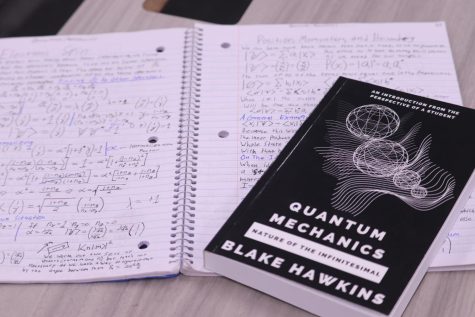Hawkins forging understanding in physics
Publishes book making difficult topics accessible to all
October 25, 2022
Quantum mechanics is a field in physics that details the behavior and study of particles, everything molecular and submolecular. Used as a plot point for the fantasy science fiction film Avengers: Endgame to justify time travel, the concept itself is dense and difficult to comprehend.
Coppell senior Blake Hawkins pulls a self-written, glossy, five by seven, one and a half inch thick book titled “Quantum Mechanics: Nature of the Infinitesimal” out of his faded black backpack. He hands it to me and watches as I flip through it.
“The concepts of quantum mechanics are marvelous,” Hawkins said. “When I learned quantum mechanics, I had to teach myself a lot of subcategories of that. I had to teach myself harmonics, linear algebra [and] multivariable calculus. I don’t think you should hide such a beautiful subject like quantum mechanics behind years and years of prerequisites. That’s why I wrote my book, because I want[ed] to put everything in one place, self-contained.”
Like how most teenagers wear their favorite bands or sports teams on faded T-shirts, Hawkins displays Maxwell’s equations plainly printed on a black crewneck. He owns several, each a different concept and theory.
Hawkins raises his eyebrows as his blue eyes dance with excitement, ready to launch into a detailed explanation of string theory or lagrangian mechanics. Like how some may get lost in hours of practicing the piano or perfecting a portrait, Hawkins surrounds himself with cloth-bound textbooks and the work of past physicists.
“I read a book by Stephen Hawking called The Grand Design,” Hawkins said. “I was intrigued. I didn’t understand everything that was in it. But there’s an explanation that I remember in particular, on why straws look like they bend in water. That showed that anything can be explained if you were observant enough. I started looking and finding more ways that I could explain things that I may have overlooked in the past and explore new phenomena.”
I pick up the book and observe the smooth black back cover. A yearbook photo accompanies a personal statement. I indicate that I am thoroughly impressed, both by his verbiage and the book itself. He smiles, but quickly moves past the compliment to further explain the contents of the book.

“First and foremost, you’re going to be able to understand the origins of a lot of topics in quantum mechanics. It tells you the history, the understanding of the atom, why we even have quantum mechanics in the first place, which I won’t spoil,” Hawkins said. “I introduce what’s called Dirac notation, which is a fancy version of linear algebra that is used for quantum mechanics because it works amazingly well. I don’t really get into relativity there. But in my next one, I will.”
I continue to flip through the book, a look of confusion rippling across my face as difficult math equations appear in later chapters. Hawkins reassures me, and begins to use his hands to mimic the concepts.
“The beautiful thing about physics is that a lot of situations are really just the same thing,” Hawkins said. “Like oscillations in a circuit. You can use complex numbers to model a spring oscillating. At its most fundamental level, everything can be described the same. I think the best example of that is what’s called the Langrarian, which is basically conservation of energy.”
Hawkins first found an interest in physics in sixth grade. What many overlooked, Hawkins seeks to explain. After learning why airplanes had the capability to fly, Hawkins wanted to calculate lift force in relation to the difference in density of the fluid the airplane is traveling through.

I interject and ask if he’s ever watched Interstellar. While most would remember the major plot points of the movie starring Matthew McConaughey or Jessica Chastain, Hawkins recalls the physics behind space travel.
“Time dilation stuff?” Hawkins said. “That’s a real thing. It happens. I have another book I wrote about relativity. It’s short. It’s like 30 pages, because it’s a derivation of what are called the ensign paper equations.”
According to AP Physics teacher Stephanie Sloane, Hawkins was always striving to learn and understand more of the subject. He was known as someone who you could go to if you had questions, and he would always patiently explain the concept.
“At the end of the year, I had him teach [relativity]” Sloane said. “I knew it was something that he was interested in, and that he’d give a different perspective from what I was doing. And so I was like, ‘Hey, you want to teach this subject?’ He did a great job. He had some practice built into the lesson. He did a really good job on that topic, so I’d have him back as a guest speaker.”
Hawkins founded the Physics Olympiad Club at CHS and is currently training his peers for F equals MA, which is a qualifying exam to compete in the national competition of American Association of Physics teachers.
“He’s really patient,” senior Physics Olympiad member Andrew Yin said. “He understands the ideas so he’s able to explain it in a way that’s friendly to people who don’t understand Physics. That makes him a really good teacher.”
Hawkins stands up multiple times to explain the different topics of study. He uses his hands to explain momentum and force, visualizing the concepts to me before moving on to explain the next.
“If you understand physics, you hold the key to understanding everything,” Hawkins says “By just pursuing this you can, to some degree, comprehend the entire universe, and all of its glory. Or even more than one universe. You get in string theory, you can look at initial conditions and define an entirely new universe that has different laws of physics. But there’s still central physics of the multiverse that governs that.”
Follow @angelinaliiu and @CHSCampusNews on Twitter










